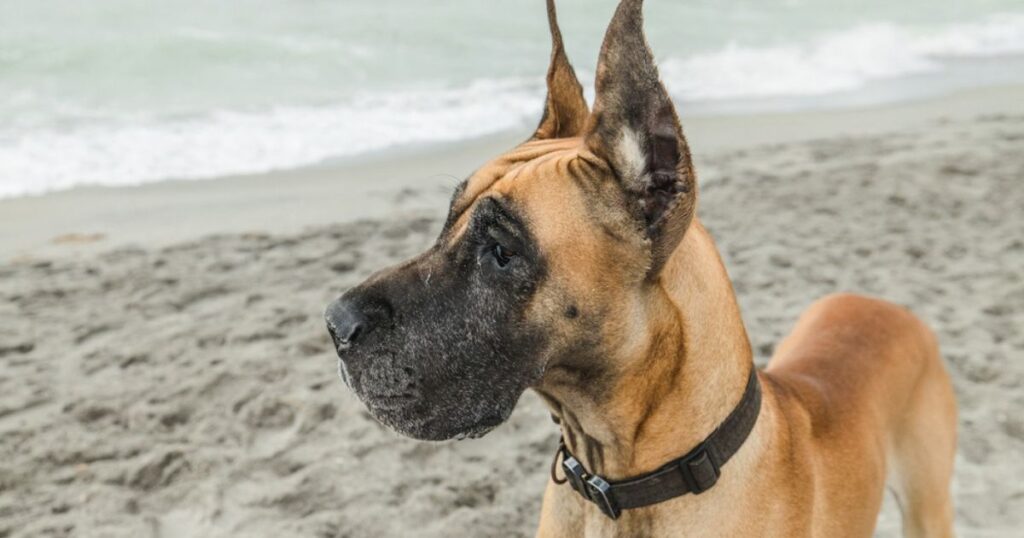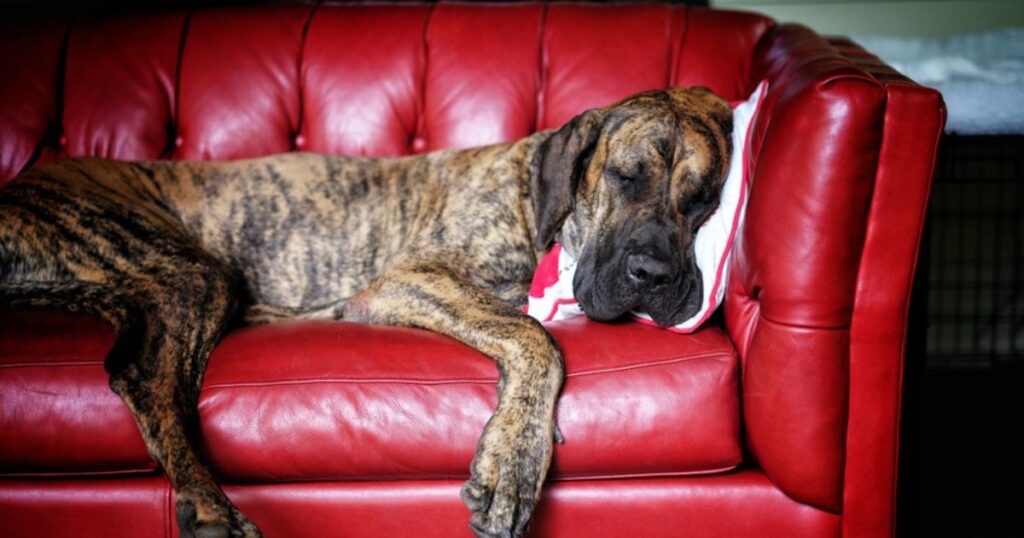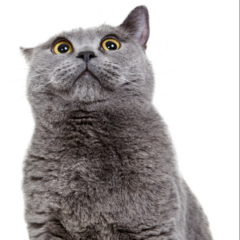- Pumpkin Team
- May 21
- 7 min read
Updated: Nov 5
Key Points
Great Danes are giant-sized working dogs, but behind their imposing build, they’re loyal, protective, and affectionate.
These playful dogs have inspired many iconic cartoon characters, including Scooby-Doo and Marmaduke.
While generally healthy, this deep-chested breed can suffer bloat, a life-threatening medical condition.
You may have seen one at a dog park, in films, books, or center stage at the Westminster Dog Show, but no matter where, Great Danes certainly turn heads! They stand head and shoulders above other dog breeds — literally. Known as the “Apollo of Dogs,” these gentle giants are beloved for so much more than their size and good looks. Because despite their intimidating size, Danes are playful and affectionate pups that bond strongly with their loved ones and show incredible patience with small children.
But is the mighty Great Dane the right fit for your lifestyle? Every dog is special, but not every breed might be suited for your lifestyle. This is something Naomi Watts’ character certainly uncovers when she decides to take in Apollo in the new film adaptation of the best-selling novel “The Friend.” When she first adopts Apollo, she struggles with keeping him hidden because of her apartment’s rules around pets.
First-time dog owners might struggle to handle such a big dog, but these pups can also be surprisingly low-maintenance. They’re well-known for their trainability, dignified nature, and occasional goofiness. After enjoying a brisk walk around the block, don’t be surprised if your Dane tries to climb onto your lap to cuddle on the couch, drooling on your cushions all the while.
If you’re considering adopting one of these working dogs, then keep reading to learn more about the Great Dane lifespan, breed characteristics, history, and interesting facts.
1. The Great Dane size and weight
So, just how tall are Great Danes? According to the American Kennel Club (AKC), males usually stand 30-32 inches at the shoulder, weighing 140-175 pounds. Females are a bit smaller, standing between 28-30 inches at the shoulder and weighing between 110-140 pounds. Standing upright they can be about the height of a 5 year old human child, if not taller. Standing on their hind legs, males can easily tower over someone who is 5’4'' when they are fully grown.
While individual Great Danes dominate the record books for their size, Great Danes are not considered the largest overall dog breed. That honorable title goes to the Irish Wolfhound, which can stand at least 30 inches tall.
2. They’re not really Danish
Great Danes were established as a distinct breed more than 400 years ago, and over the past few centuries, they’ve had many names. For example, in Germany, these dogs are called “Deutsche Dogge,” which translates to “German Mastiff.”
A Frenchman was the first to call them Great Danes after encountering one of these giants on a trip to Denmark. He called them “Grand Danois,” and the name stuck. Despite the name, Great Danes have no connection to Denmark, as the breed was originally refined in Germany.
3. Great Danes are a top dog
Great Danes rank 21st in the AKC’s list of the most popular dog breeds of 2024, making them moderately popular purebreds. While you might expect the price of a Great Dane to correspond to their size, they range in price from $500-$1,800, on par with other working dog breeds.
4. These dogs come in a variety of colors and patterns

Great Danes come in 17 different colors and 10 distinct patterns. Fawn with a black mask is among the most common; harlequin is perhaps the most distinct. This is when a Dane has a solid white coat with black blotches, resembling a Holstein cow. They can also come in blue, brindle, or mantle, which is a dark base coat broken by black spots.
As with all dogs, Great Danes do shed, though not excessively. Vacuuming their short hair every other day should keep your black pants fur-free.
5. These dogs are a working breed
The AKC categorizes recognized breeds into seven categories. Great Danes are classified in the working group because of their origins as hunters and guardians. Other dogs in the working group include the Dogue de Bordeaux, Anatolian Shepherd Dogs, and Boerbels — all large mastiff-type dogs. Because of their work history, Great Danes are naturally protective guardians.
6. Danes are Pennsylvania’s official state dog
Although Great Danes originated in Germany, they made their way to the United States by way of England, with help from William Penn. These powerful dogs made great hunting companions in Colonial Pennsylvania, and they were recognized for their loyal nature when they became the official Pennsylvania state dog 1965. A portrait of William Penn and his Great Dane hangs today in the Governor’s Reception Room in Philadelphia.
7. These dogs eat A LOT
It may come as no surprise that the bigger the dog, the more they’ll eat. Giant George, one of the previous record holders for the world’s largest dog, was a blue Great Dane weighing 245 pounds and standing almost four feet tall. He ate 110-130 pounds of chicken and kibble a month.
Your veterinarian can identify an appropriate meal plan for your dog, and they’ll likely recommend a protein-rich, low-carb diet.
8. This iconic breed has inspired many cartoon characters
Aside from their sheer size, Great Danes are so recognizable because they’ve inspired many iconic characters. In the Hanna-Barbera universe, both the eponymous Scooby-Doo and Astro from The Jetsons were Great Danes. Marmaduke, a mischievous but lovable Dane, also starred in his own comic strip, which launched in the 1950s. It later inspired a 2010 feature-length film about the character’s misadventures starring Owen Wilson.
9. Great Danes have a short-but-sweet lifespan
Like all giant dogs, Great Danes don’t live as long as pint-sized pups. In general, smaller dogs live longer than larger breeds. So, how long do Great Danes live? The average Great Dane lifespan is between 8-10 years. To spend as much time with your pup as possible, be sure to practice preventive care and take them for regular vet checkups. Feeding them a balanced diet and giving them enough mental and physical stimulation is also beneficial.
10. Great Danes are prone to some health problems
As a breed, Great Danes are healthy dogs who generally have a lifespan of 8-10 years. Because of their unique physique, they are especially prone to gastric dilation and volvulus (GDV), also known as dog bloat. This life-threatening phenomenon occurs when a dog’s stomach fills with gas and twists on itself, blocking blood flow to major organs.
Veterinarians aren’t entirely sure what causes this condition, but they’ve determined a connection between GDV and eating too quickly.
11. Kevin holds the record for the world’s tallest dog
Giant George, the one-time largest dog in the world, sadly passed away in 2013 after enjoying a seven-year lifespan. However, Giant George wasn’t the only record-breaking Dane in the history books.
According to the Guinness Book of World Records, another Great Dane (named Zeus) held the record for being the world’s tallest living dog (3 ft 5.18 in) until his passing in 2023. Kevin, named after the Home Alone character, was the last dog to hold the record for the tallest living dog in 2024, as of writing this article. He stood at 3ft 2in from his feet to his withers and 7ft when he stood on his hind legs.
12. Some Great Danes are natural athletes!

While Danes have reputations for being great nap time companions, they’re also familiar faces in the world of dog sports. Because of their remarkable sense of smell, some Danes thrive in scent work, which is centered around tracking an object using their nose. Danes also enjoy include dock-diving, fly ball, and obedience trials.
How to improve your Great Dane’s lifespan
Sadly, many lovers of these gentle giants know that their dogs might not live to see the double digits. However, the good news is that there are ways to keep your Dane healthy and promote their longevity. While a veterinary nutritionist can explain more, feeding your dog a complete and balanced diet at each stage of their life can reduce the stress on their joints and maintain an ideal weight. Encouraging your dog to use a slow feeder can also reduce the risk of GDV.
Should you get a Great Dane?
So, is a Great Dane right for your family? The answer depends on many factors, including your lifestyle, expectations, and experience level with big dogs. Regardless of the breed you choose, you’ll want to set your four-legged friend on the path to a long and happy life. Pumpkin Dog Insurance plans can help pet parents focus on the best in care when facing life’s unexpected accidents and illnesses.
FAQs
Do Great Danes make good apartment dogs?
The answer truly depends on the individual dog’s temperament, but in general, big dogs demand bigger spaces. Despite their reputation as lovable people-pleasers, Great Danes also have loud, rumbling barks that could disturb your neighbors. At the same time, these dogs have a reputation as couch potatoes and don’t require vigorous exercise.
Are Great Danes good with kids?
Great Danes have a reputation for being amazing family dogs who are remarkably friendly with children. Of course, always supervise Danes around small children. Even an excited 100-pound puppy could accidentally injure a toddler while playing.
What were Great Danes bred for?
The original Great Danes were bred for hunting wild boar in Germany. Today, Great Danes are more popular as family dogs and guardians than traditional hunting companions.
Can you mix a Great Dane with a Chihuahua?
Breeding healthy puppies is all about finding suitable parents with compatible physical traits. While you technically could mix a Great Dane and Chihuahua, the result would likely be dogs with weak joints, congenital defects, and other life-hindering physical issues, such as enlarged organs. The logistics of producing a Great Dane-Chihuahua mix would be challenging, too.
REFERENCES

